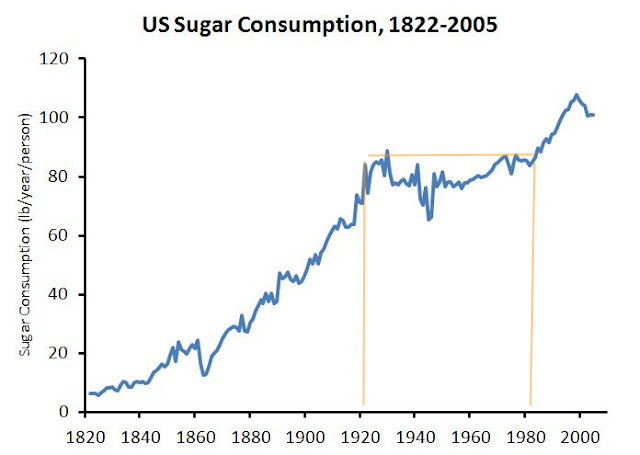Why diabetes is an electrical illness
Sugar isn't the main ingredient in this epidemic
What do Thomas Edison & Alexander Graham Bell have in common?
No they weren’t rats.
They were both diagnosed with diabetes after conducting electrical experiments.
John Rollo wrote the first book on diabetes in 1798 and had only seen three cases himself in the twenty-three years he practiced medicine.
In 1876, many practitioners such as Benjamin Richardson considered diabetes to be “a modern disease caused by exhaustion from mental overwork or by some shock to the nervous system. Yet it was still uncommon.” [i] [ii]
How did diabetes come to be one of society’s greatest killers?
Let’s play the Blame Game.
Sugar is only one of the culprits and fails to explain why diabetes is becoming increasingly prevalent.
Even after sugar consumption did not rise at all between 1922-1984, rates of diabetes skyrocketed tenfold.[iii]
The following excerpt is paraphrased from The Invisible Rainbow, a highly-recommended read by
:The American Indians have been called “genetically predisposed” to diabetes. We’re told that this predisposition is triggered by a sedentary lifestyle of living on the reservation.
This is compounded by the fact that they eat fry bread made with white flour and sugar.
However, Indians have been eating fry bread as a staple since the late 1800s, and diabetes did not exist among them until 1950.
In 1950, the first electric service came to Standing Rock in the Dakotas, along with others including the Gila River Reservation, whose inhabitants were revealed in a study conducted by the US Indian Health Service to have 380 cases of diabetes per 1000.
Bhutan, an isolated community in the Himalayas that abides by its traditional culture and ancestral foods to this day, serves as another salient example.
Bhutan had some of the healthiest people in the world, with little disease.
There was no electrification in most of the country, until 2002, when the Bhutan Power Corporation was launched. In 2004, 634 new cases of diabetes were reported in Bhutan. In 2007 there were 2,541 cases with 15 deaths.[iv]
The rise in mortality and illness was even blamed on the Bhutanese diet, one that they had followed for thousands of years.
Obesity as a Symptom of Diabetes
Before the 1900s, diabetics were also not overweight. Today, most are overweight due to their cells’ reduced ability to metabolize fats. Impairment of fat metabolism is a sign that the engines of our cells, the mitochondria, aren’t working efficiently.
Mitochondria are disturbed by non-native electromagnetic fields (nnEMF) such as radiowaves and WiFi, and require certain enzymes in order to efficiently generate energy for our bodies.
EMFs from wireless and cellular dampen this enzyme activity, and our cells cannot breakdown or metabolize food efficiently. For more information on how we can ensure cytochrome C oxidase functions optimally, check out my previous post here:
In 2010, Harvard, along with the University of Massachusetts and Joslin Diabetes Center, published a review of the role of mitochondria in diabetes, and concluded that there was a “failure of mitochondria to adapt to higher cellular demands.”
How Does Radiation Effect our Blood Sugar?
During the Cold War, the Joint Publications Research Service translated foreign documents of Soviet research, which showed how participants exposed to electromagnetic fields similar to those of the cordless phones and cell phones we have today, were prediabetic and had sugar in their urine after the experiments.[v]
Research also showed how radiation would deprive our cells of oxygen.
In 2011, Finnish researchers conducted brain scans and submitted their findings in the Journal of Cerebral Blood Flow and Metabolism, showing that glucose metabolism is disrupted in the region of the brain next to a cell phone. [vi]
Another Unexplained Spike
In 1997, diabetes cases soared 31% in one year. This is the same year that cell phones were no longer a luxury and became a commonplace necessity.
Before 1997, rural areas of the US did not have cell towers.
Wild Fat Rats Can't Stop Eating Sugar too?
David B. Allison, Professor of Biostatistics at the University of Alabama School of Public Health, analyzed over 20,000 animals from twenty-four populations, and found that the average weight of the animals rose over time. [vii]
Chimps gained the most and were twenty-nine times more obese in 2005 compared to 1985. Even country rats were 15% more obese each decade, over a period of 40 years.
Wild and domestic animals had both been gaining weight since at least the 1940s.
Still think obesity is about food?
Thank you for reading! If you found this content valuable, please SHARE!
Work with us 1:1 - https://calendly.com/romanshapoval/welcomecall
Private 1:1 Holistic Health Coaching (4 spots available):
Learn how to sync your circadian rhythm and use the Sun in order to:
Amplify your metabolism
Enhance mental focus
Restore sleep.
In Love & Light,
Roman & Bohdanna
[i] Richardson, B. Diseases of Modern Life, 1876.
[ii] Firstenberg, A. The Invisible Rainbow, 2017.
[iii] Stephan Guyenet and Jeremy Landen, Whole Health Source
[iv] Pelden, 2009.
[v] Bartonicek, V. 1964
[vi] Kwon et al. 2011
[vii] https://pubmed.ncbi.nlm.nih.gov/21106594/









I've unlocked the ability to leave comments. I apologize. If anyone is interested, you can now post comments here.
I guess it's what can we do? Go BACK 100 years? Try to invest in
EMF protection? It's like how we live is killing us?